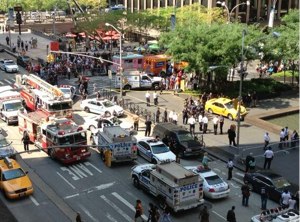Last Friday WNYC ran a piece in which Bronx vehicular crimes chief Joe McCormack explained why he thought Manhattan District Attorney Cy Vance failed to file charges against the cab driver who drove onto a Midtown sidewalk and severed the leg of tourist Sian Green. The story offers valuable insight into the mindset of prosecutors, but key questions about the case remain unanswered.

McCormack said that in order to charge Faysal Himon with a crime, the Vance team would have to prove intent. "What we look at in the criminal arena is when the mistake is greater than ordinary negligence and rises to criminal negligence," McCormack said. "And what a defendant can be charged with depends on case law."
Reporter Kate Hinds also points to the "rule of two," an arbitrary standard that holds that a New York State motorist who is breaking at least two traffic laws at the time of a crash may be charged with criminal negligence, as a possible factor in the decision not to charge Himon.
Civil attorney Steve Vaccaro believes Vance might have gotten a conviction on misdemeanor charges -- third degree assault and second degree reckless endangerment -- that don't require prosecutors to prove intent. As for case law and the "rule of two," recent decisions by the Court of Appeals, the state's highest court, have made it harder for prosecutors to secure ironclad convictions against motorists who injure and kill. But does that mean reckless drivers can't be held accountable for maiming and killing innocent bystanders?
One Court of Appeals case in particular looms large: People v. Cabrera, which held that reckless driving had to be "morally blameworthy" to sustain a homicide conviction. Maureen McCormick, head vehicular crimes prosecutor in Nassau County, explained the Cabrera ruling to Streetsblog in 2009:
[A]s recently as May 2008, New York’s highest court held that a 17-year-old driver who violated his junior license by driving with four unrelated passengers, without seatbelts, and who also was speeding at 70-72 mph through a curve with a posted caution speed of 40 mph, and who lost control sending the car over an embankment and killing three of his passengers, could not be held criminally liable. This decision alone has resulted in numerous defense motions to have cases dismissed claiming that "speed alone" or any traffic infraction "alone" is not sufficient to sustain criminal negligence.
McCormick continued: "Our position is that this is nonsense. A person driving 100 mph in front of the court on Centre Street in Manhattan at lunch time when the streets are flooded with pedestrians MUST be chargeable with a crime."
Court precedents do have a chilling effect, but as McCormick indicates, the "rule of two" is a defense strategy. It's up to prosecutors and police to decide whether they want to cede the argument by never filing charges in the first place.
Even if you accept the "rule of two" as the standard, there are a number of serious crashes for which drivers in New York City should have been prosecuted, but were not. Here is a partial list. Arguably, the Sian Green case could be added to it.
Driving on a sidewalk is not a crime in New York City -- but it is a traffic infraction. So is careless driving. Had Himon been issued these two summonses, theoretically that would have been sufficient for Vance to pursue a criminal case. Yet after a two-month investigation of a crash in which the driver mounted a curb in broad daylight in the heart of crowded Midtown, striking two people, Vance's office declined to file charges.
Why didn’t Vance try to get a conviction for assault or reckless endangerment? Why was evidence gathered from interviews, surveillance video, 911 calls, and black box data deemed insufficient to support other charges? Why didn't Vance make a case based on the "rule of two"? The public still doesn't know.
The nut of the WNYC piece is this quote from Juan Martinez, general counsel for Transportation Alternatives: "We need prosecutors to bring tough cases to fix the case law," Martinez said. "And we need legislators to change the law." This won't happen as long as prosecutors and police continue to duck responsibility for bringing reckless drivers to justice.





